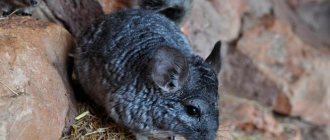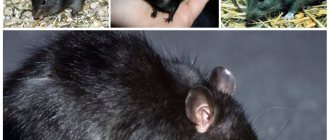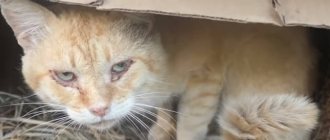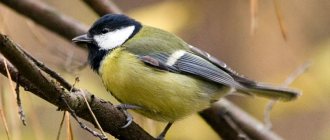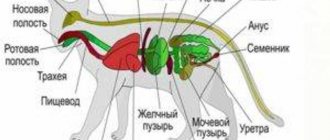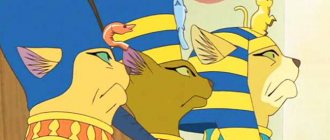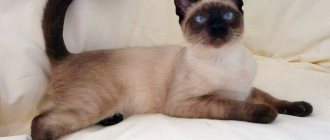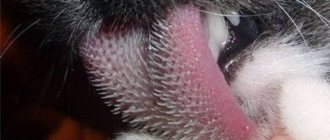Big kind eyes, long luxurious hair and aristocratic habits - all this is a delightfully beautiful Persian cat. Pets have captivated thousands of owners around the world. With proper care and attention, the Persian cat will become a full-fledged member of the family and the best friend for children.
But before getting a long-haired “Persian,” future owners ask themselves the question: how long do Persian cats live at home? Let's try to understand the burning issue, as well as find out what factors will extend the life of a furry pet as long as possible.
History of the origin of the Persian cat breed
global $ads_google;
//data-ad-slot=”2475549904″ $ads_google = empty($ads_google) ? false : true; ?> if ($ads_google == false) {?> $ads_google = true; ?> } ?> Traveling through the Persian province of Harassan, the Italian Pietro Della Valle returned to his homeland not alone, but with several long-haired cats at the beginning of the 16th century. Outwardly, these creatures more closely resembled an agnorka or a van, but, nevertheless, they were strikingly different from the usual feline appearance.
Today we call the breed Persian according to the first reliable mention of the country of origin of cats according to the testimony of the Dutchman Van de Werff, who studied descriptions of the life of Ancient Persia.
The further history of the Persian cat is known: the long-haired creature in the 19th century attracted the attention of German breeders who tried to breed a breed with improved coat qualities and stocky body. Then, already in the 20th century, American breeders took up the breed and “gave” the Persian his famous face with childish, naive eyes. As a result, an extreme type appeared and remained a classic one.
Life on the street
The average life expectancy of yard or walking cats is significantly less than that of their domestic relatives. Their age rarely exceeds 10 years and this is influenced by several factors:
- weather;
- lack of food, hunger;
- increased risk of various diseases;
- the likelihood of injury or poisoning;
- stress.
The life of a pet directly depends on its owner. Therefore, answering the question of how long domestic cats live after castration is only possible in general terms. Castration alone is not enough to prolong life. It is important to constantly pay attention to your pet and feed him quality food.
Experts recommend neutering your pet at the age of 6-8 months. This is considered the optimal time for the procedure, since the cat’s genitals are already developed. However, he was not yet interested in representatives of the opposite sex.
Description of Persian cats
The external characteristics of cats of the Persian breed are impressive: according to the description given in the WCF standard, you can recognize this cat, even if you have never met it in your life. The body, medium to large in size, appears stocky, short and compact. Rounded paws with tufts of hair between the toes, go well with thick and strong limbs.
The pet of this breed is famous for its strong chest, massive shoulders and generally developed muscles.
The round head is located on a short and powerful neck. Since the skull is convex, the head is proportional to the full cheeks and convex forehead; a short and wide nose with a noticeable, distinct stop looks funny on the muzzle. A feature of the appearance of cats is the location of the upper border of the nose no higher than the lower eyelid. A wide chin and a massive lower jaw look harmonious on the face.
The look of cats is interesting: it is open, questioning and very expressive.
Persians have small ears with rounded tips, which are located low and wide on the head in relation to each other.
The tail is heavily pubescent, although in itself it is short and thick, the hair on it is long.
Cats' fur is thin, silky and very thick, despite its considerable length.
Persians are not a hypoallergenic breed.
global $ads_google; //data-ad-slot=”2475549904″ $ads_google = empty($ads_google) ? false : true; ?> if ($ads_google == false) {?> $ads_google = true; ?> } ?>
The colors are numerous and are divided into several basic varieties:
- solid or solid;
- color point (without white impurities);
- ticked (tabby and agouti);
- shaded or chinchilla;
- bicolor;
- calico;
- smoky.
The color shades of the colors vary: from dark to light tones, each variety has its own criteria.
Varieties of Persian cats
Among Persian cats, there are several varieties with certain characteristics of appearance and color.
The appearance of the classic Persian is similar to an ordinary cat, since their nose is also located slightly below eye level up to 2 cm. This type is considered outdated and is characteristic of the original appearance of the animal. The muzzle is slightly flattened, a slight snub nose is noticeable. Classic Persians are bred today mainly in Europe, and are increasingly called the European type.
The extreme type has a strong snub nose and flattened muzzle. The nose of the extreme sportsman is almost at the same level with the upper eyelid. Characterized by a bulging forehead and deformed jaws. The nose is strongly “pressed” into the skull. The second name of the breed branch is American Persian.
When a Persian cat was crossed with a short-haired American cat, they got an exotic cat whose face resembled an extreme Persian, but with thick short hair.
The hybrid between extreme and classic is called the short-nosed Persian; it is an intermediate type between these varieties.
The Persians also became the founders of an interesting new breed called the Selkirk Rex.
Dimensions and weight of Persian cats
global $ads_google;
//data-ad-slot=”2475549904″ $ads_google = empty($ads_google) ? false : true; ?> if ($ads_google == false) {?> $ads_google = true; ?> } ?> The long-haired fluffies are medium to large in size by cat standards. The male's weight is always greater than the female's. A cat usually weighs between 5-7 kg, and a female cat about 3.8-5 kg. Newborn kittens with proper nutrition grow quickly, delighting owners with growth dynamics every month. Animals reach standard weight by one and a half years.
Small domestic Persian pets do not exceed 30 cm in height.
Table of weight of Persian cats by month
| Age | Female | Male |
| newborn | 95-130 gr | 110-150 gr |
| 1 month | 390-470 gr | 410-520 gr |
| 2 months | 560-910 g | 690-1100 gr |
| 3 months | 1-1.4 kg | 1.2-2 kg |
| 4 months | 1.4-2.2 kg | 1.7-2.9 kg |
| 5 months | 1.9-2.6 kg | 2.1-3.5 kg |
| 6 months | 2.2-3.3 kg | 2.6-4.3 kg |
| 8 months | 2.7-4.1 kg | 3.5-5.1 kg |
| 10 months | 3.1-4.5 kg | 4-5.8 kg |
| 1 year | 3.5-4.8 kg | 4.6-6.5 kg |
| 2 years | 3.8-5 kg | 5-7 kg |
Lifespan
How long do castrated cats live? At home, they live up to 15-18 years. They do not have "street" dangers such as fights with other males. They will not receive any mechanical injuries and will not become infected with dangerous diseases.
Life expectancy is also affected by breed. It is noted that castrated Siamese, Persian and British cats, on average, live up to 15 years.
However, the owner must maintain a healthy lifestyle for the pet. In order for a cat to please its owner with its health and longevity, it is recommended to follow the following rules.
- Take your pet to the veterinarian regularly.
- Give your cat time so that he doesn’t switch to food.
- Create a diet for your pet to avoid obesity.
Habits and character of Persian cats
An obedient Persian kitten fits perfectly into a home environment, as its character makes it easy to accept the rules of behavior set by the owner of the house. Raising a baby goes smoothly; contact is quickly established between the attentive owner and the baby.
Reviews from people who keep such gorgeous cats speak about the intelligence of their pets, their restraint and affectionate nature.
Kittens are quite smart and are able to quickly learn to use a litter box, especially with the proper human approach to training the baby. A growing pet lends itself well to simple training, which brings it even closer to its owner. The difficulty may be the manifestation of disapproval on the part of the owners - the Persian cat's soul is very vulnerable.
The whole family loves to observe the habits of peaches: the cat easily gets along with other pets, does not offend poultry, and studies every nook and cranny of the home with interest. If a random mouse wanders into the house, the cat will not miss the chance to catch it - for him this is another interesting toy.
Children love to stroke such a long-haired animal, but it’s worth explaining right away that if the pet is not inclined to such caresses, it is better to leave it alone.
Advantages and disadvantages of the procedure
After castration, the cat becomes calmer and more balanced. He will not get into a fight and will not leave the house for a long time. The possibility of contracting sexually transmitted diseases is excluded.
The main disadvantage is the pet's subsequent tendency to overeat. This often leads to obesity. In castrated cats, the production of hormones is disrupted, and obesity can occur due to hormonal background.
If a neutered pet eats natural food, it increases the risk of urolithiasis and other kidney pathologies. For this reason, it is recommended to prepare a menu for your pet in advance.
Feeding and caring for Persian cats
global $ads_google;
//data-ad-slot=”2475549904″ $ads_google = empty($ads_google) ? false : true; ?> if ($ads_google == false) {?> $ads_google = true; ?> } ?> The coat of the Persian breed is extremely long for cats and very thick, hence the difficulties associated with grooming. Such a fur coat requires daily attention: combing should become a habitual procedure. Otherwise, tangles will form very quickly in the tightly tangled hairs. Some breeders advise not just combing the coat, but adding a little talc to it. The cat quickly gets used to grooming, because they begin to care for the pet as soon as it gets into the house. Claws can be trimmed once every couple of weeks.
Long-haired cuties are not very happy about washing, but you still have to do it - special shampoos will help maintain the beauty of the coat and the health of the skin.
The clean peach very often licks the skin, so he must be given a special paste so that lumps of hair that get into the stomach do not harm the life of the cat.
What to feed a Persian kitten for 2 months
Keeping a Persian guest in the house dictates its own conditions: you must follow the recommended monthly feeding schedule for the kitten. An adult domestic cat is fed 2-3 times a day, with the bulk of the food being proteins: low-fat dairy products, sea fish, cheese, eggs. Peaches benefit from vegetable and grain porridges, to which you can also add pieces of cheese and fish.
Factors
The lifespan of Persian cats depends on many factors . Let's look at a number of them:
- Balanced diet.
- Cat's weight. Nutrition should be balanced, including vitamins and minerals. You should not over-fed your Persian cat. An overweight cat loses activity, sleeps a lot, and becomes apathetic. Problems with excess weight affect the respiratory system and heart. Walking in the fresh air, playing with other animals and children have a positive effect on the health of Persian cats.
- Proper care. A very important point. It would seem that trimming nails, combing fur and bathing, what’s special about that? Personal hygiene is especially important for cats. They are notoriously clean, but they can’t do everything on their own. It is not recommended to blow-dry your Persian cat to preserve its beautiful long coat.
- The nose and eyes require special care. If necessary, clean the animal's eyes from pus and discharge with a cotton pad. You can pre-moisten it in a solution of potassium permanganate or tea leaves. The ears are cleaned several times a week with a damp swab, strictly excluding cotton swabs.
- Taking medications against parasites and preventing fleas will significantly prolong the life of your pet. Parasites and insects affect the health of the animal, and they also spread diseases.
- Genetic and other diseases. Unfortunately, Persian cats are susceptible to some hereditary diseases that can significantly shorten the pet’s life. The breed is characterized by heart, kidney and urinary system diseases. Given this fact, a diagnosis from a veterinarian will not be superfluous.
- Extreme Persians, having an upturned nose, experience great breathing problems. The organ often becomes clogged with debris and dust.
- And most importantly. Love and affection, responsibility towards those whom we have tamed will increase the lifespan of a Persian cat.
Many owners are tormented by the question - which food is preferable for their pet, natural or dry food? There is no clear answer to the question. We can say that natural nutrition is preferable. But, for example, there should not be an excess of fish (especially sea fish) in your pet’s diet.
Contrary to popular belief, such a product negatively affects the life expectancy of a pet. Another common product is milk. You should not abuse dairy products, even if they are natural, from the cow. It is better to replace milk with low-fat cottage cheese. Experts recommend boiled meat, boiled eggs, and a variety of cereals.
We exclude from the diet the remains of the owner's food, spicy, sweet or fatty. Large pieces or bones can cause the animal to choke. The main thing can be said about dry food.
The diet uses exclusively premium food (Wiskas and others do not belong to them). In addition, it is useful to periodically change the types of food or switch your pet to natural products.
Persian health
All living beings have a tendency to some kind of disease. And this wonderful breed is also susceptible to certain diseases, including polycystic kidney disease. This disease sometimes leads to kidney failure in the cat's advanced age and old age. In order not to miss the first symptoms, you need to monitor the health of your older pet and if you suspect any abnormalities, immediately contact a veterinarian. It makes sense to monitor the heart condition of your breed pet, as sometimes they develop cardiomyopathy. Since the breed is classified as large, it is prone to hip dysplasia.
Timely vaccinations will protect your dog from many health problems. Vaccination of the breed is carried out according to the schedule established by the veterinarian.
After mating, the cat becomes pregnant; the gestation period depends on the number of babies in the belly. Childbirth occurs in 63-66 days. If you do not want offspring from your pet, it needs to be castrated or sterilized at the age of 9-12 months.
Eye care for Persian cats
global $ads_google;
//data-ad-slot=”2475549904″ $ads_google = empty($ads_google) ? false : true; ?> if ($ads_google == false) {?> $ads_google = true; ?> } ?> Most often, owners are worried that the Persian cat’s eyes are watery . Due to the physiology of the structure of the muzzle in this breed, the tear streams are practically blocked, which makes the charming cat a chronic crybaby. If you eliminate this cosmetic defect every day by washing your eyes with a soft, clean cloth, this will eliminate traces of “tears” on the face and make life easier for your pet. It is impossible to treat the problem anyhow, as constant discharge will thin the hair around the eyes, and it will begin to come out.
You can alternate washing your eyes with warm water and treating the area around the eyes with a mixture of boric acid, hydrogen peroxide and starch. Sometimes, even with proper care, brown discharge flows from the cat’s eyes, or the eyes begin to fester: in these cases, do not postpone a visit to a specialist.
How long do Persian cats live?
Since the life of Persian cats takes place at home under the constant control and care of the owner, their cat’s life expectancy is on average 12-17 years
.
If you spay or neuter a cat before one year, their lifespan will increase - with good care, a pet of such a generally strong breed can live up to 20 years
. This is explained by smooth hormonal levels and human care, which also includes specialized nutrition and timely treatment of diseases.
How long do cats live on average?
Domesticated cats (without regard to their gender) stay in this world for about 12–15 years . But precedents for cats crossing the 18-20 year mark are not so rare.
Some sources also contain more fantastic figures (36–38 years), allegedly supported by the testimonies of those who were lucky enough to raise long-lived cats. This information can hardly be considered 100% true due to the lack of official confirmation.
Domestic cats that have lived next to their owners for 20 years or more are not considered curiosities. As a rule, their long life is ensured by strong heredity and owners who were able to optimally organize the cat’s life, nutrition and leisure.
Some people are still convinced that stray cats are more adapted to harsh reality than their domesticated counterparts, and, therefore, differ from the latter in having a longer life span.
In reality, everything looks exactly the opposite: street cats rarely live even up to 10 years, and on average they live 6–9 years. The explanation is simple: yard animals are surrounded by external dangers (threatening infections, lack of food, bad weather, flayers, dogs and cars) and are in constant stress.
Return to content
Buy a Persian kitten
The popularity of the breed provides ample opportunities for its acquisition, and non-professional people often take advantage of this. They are not responsible for the health of a small representative of such a popular breed and its physical and hereditary genetic data, so you should not choose a baby on sites that have nothing to do with professional nurseries.
global $ads_google; //data-ad-slot=”2475549904″ $ads_google = empty($ads_google) ? false : true; ?> if ($ads_google == false) {?> $ads_google = true; ?> } ?>
To avoid getting into trouble, you need to know in advance what documents should accompany the purchase of a Persian. The breeder is required to provide pedigree records, a veterinary passport indicating the vaccinations given and notes on genetic tests.
The nursery will also demonstrate the kitten’s parents; you will be able to observe all the babies in the litter and visually verify their health.
The price of kittens of this breed depends on the class to which they belong. The cost of a classic cat and an extreme cat is approximately the same. You can buy a pet-class kitten at a price from 7000
rubles, breed class from
15,000
rubles and show class from
25,000
rubles.
What to name a Persian cat
When a Persian cat appears in the house, everyone in the house wants to choose the most beautiful name for it. There is no need to rush, it is better to observe the baby and its habits; this often helps to decide on the pet’s name. Sometimes the decisive word is “said” by the color of the cat (black, blue, white, red).
For a chic fluffy girl, you should choose a gentle and regal name.
A boy with such a presentable appearance also has the right to a euphonious name. If you have difficulties with selection, you should refer to the large list of nicknames suitable for the breed, not forgetting to focus on the names in the pet’s pedigree. Names for Persian kittens
| Girl | Boy | ||
| Fairy Lulu Zara Alani Teona Comet Cinderella Vanessa Jaya Maha Lana Waxa Yuga Gerda Bessie | Ollie Joly Amber Mina Erma Fusya Annette Oda Adelia Pilka Pesya Ulla Leda Sonya Snezhka | Largo Katsap Barkhan Kumai Ferry Mefik Azar Zembi Kasper Elbar Barry Dick Maris Simba Bob | Nils Archie Moth Nemo Marcus Blair Mickey May Fluff Raf Lucky Tisha Filya Indie Ike |
Relationships with other animals, children
Persian cats have an obedient, quiet, calm disposition. Adults are not hyperactive and love to spend their time basking in the warm rays of the sun. Animals of this breed are open towards others and do not like to enter into conflicts. With rare exceptions, they engage in skirmishes for leadership, often with other cats rather than with larger or smaller opponents. Persians are indifferent to birds and rodents.
Persian cats communicate willingly with children, allowing them to touch them, pull their tail and whiskers. They will never attack small, defenseless babies. In critical, stressful situations, Persians are tactful and not impulsive. They would prefer to sit in the shadows rather than engage in open confrontation.
Cats of this breed can commit mischief only by accident, having forgotten themselves in the game. They will not consciously take revenge and remember something that went wrong.
Conclusions about the breed
The Persian cat is a worthy pet that will quickly become the beloved youngest child in the family. She will always be close to the owner, without imposing her attention. With the proper level of care, a cat of such a noble breed will live a long life, decorating the owner’s home with its existence. Despite the fact that his fur coat will require daily attention and care will take a lot of time, such a pet will bring a lot of joy to its owners with its affectionate character and devoted attitude towards the family.
global $ads_google; //data-ad-slot=”2475549904″ $ads_google = empty($ads_google) ? false : true; ?> if ($ads_google == false) {?> $ads_google = true; ?> } ?>
What affects the lifespan of a Persian
In addition to genetics, a pet’s life expectancy is also influenced by proper nutrition, sufficient physical activity, regular hygiene, castration or sterilization and timely vaccination.
The peculiarity of Persian cats is their long hair and short nose. Because of them, if not properly cared for, the animal begins to get sick.
The special structure of the upper parts of the respiratory system does not allow the cat’s body to fully resist viral infections. Because of this, the Persian is practically defenseless before them.
Vaccination against cat flu is mandatory annually. This is an important measure to prevent a dangerous disease. Long hair easily becomes tangled, which dramatically worsens the cat's condition.
Be sure to read:
The Persian cat is a long-haired ancient breed with its own advantages.
If you don’t have time to brush your Persian, you shouldn’t get a cat.
Sterilization and castration of animals that are not allowed to breed is mandatory. This allows you to avoid regular hormonal surges that undermine the health of Persian cats.
This reduces the risk of developing cancer, and completely eliminates some of them. When buying a kitten, you need to choose the strongest and most active one.
An animal that is born healthy has a better chance of living as long as possible.
What to look for when buying a kitten
The main factors that you should pay attention to when choosing Persian kittens are pedigree, coat color and gender. You can buy a purebred Persian baby only in a specialized nursery, otherwise you cannot be sure of the purity of the breed and the health of the cat. Before purchasing, you need to pay attention to the chosen character in a familiar environment.
Healthy Persian kittens are playful and very active.
When purchasing, you should inspect the eyes and nose, they should be free of discharge and irritation, the spine and limbs should be strong, and there should be no creases on the tail.
Responsible breeders understand that a kitten can be sold no earlier than 4 months. When purchasing a kitten from a shelter, it is important to check all its vaccinations and medical documents. If you buy a kitten online, you can also buy a half-Persian breed for your home, but it’s worth asking about the pedigree.
Important! Changes in a Persian's appearance can continue until the 3rd year of life.
Neutered pet and ensuring a long life
Some rules that will help make your pet’s life not only happy, but also long:
- To prolong the existence of your four-legged friend, you should love him, but not overdo it;
- See a veterinarian regularly;
- Feed appropriate food;
- Add vitamins and herbs to your diet;
- Provide active development;
- And, of course, fresh air.
It is very important for all neutered and regular cats to feel attention and care. Play ball, run around the apartment, communicate with him. In return, he will sleep next to you, curled up in a ball, accompany you to work and joyfully greet your beloved owner or hostess.
And don’t forget that castration protects the cat from all sorts of accidents.
This is interesting: Which food to choose for neutered cats
What diseases are typical for the breed?
Due to their strong skeleton and powerful muscles, exotics never have problems with joints and bones, but, like every artificially bred breed, they have a number of genetic diseases that complicate their physical characteristics. These are the ailments they inherited from the Persians:
- deformation of jaws and teeth;
- chronic sinus diseases;
- increased tearfulness (epiphora);
- kidney diseases;
- hypertrophic cardiomyopathy;
- difficulty breathing, accompanied by snoring (due to a flattened nose).
But American shorthair cats, on the contrary, are distinguished by good health, which they shared with their descendants - exotics. Therefore, representatives of the exotic shorthaired breed cannot be called overly sickly. The main thing is proper care and caring maintenance.
